On This Page
Best Comforters: Our Top Picks for Cozy Sleep
Our Top Picks
-
Best Overall
Layla Down Alternative Comforter -
Best Value
Olive + Crate Bamboo Comforter -
Best Luxury
Saatva All-Year Down Alternative Comforter -
Most Comfortable
Buffy Cloud Comforter -
Softest
Cozy Earth Bamboo Comforter -
Best Cooling
Zonli Z-Magic Cooling Comforter -
Best All-Season
Slumber Cloud Comforter -
Best Weighted
Baloo Weighted Comforter
Best Overall
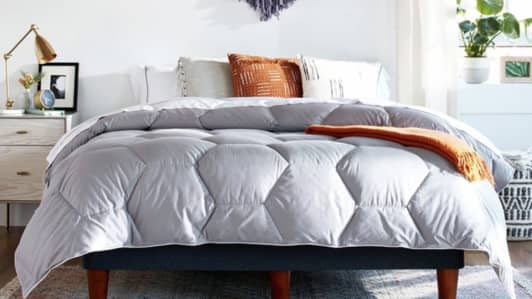
Layla’s Down Alternative Comforter is a soft and breathable year-round model. Suitable for vegans, the down alternative fill has a cluster loft similar to natural down. The hexagon baffle box design keeps the fill evenly distributed. Quality materials and versatility make the Down Alternative Comforter a solid pick for a wide range of sleepers.
Pros & Cons
Pros
- Vegan-friendly down alternative fill
- Breathable cotton cover with 300 thread count
- Available in white or gray
Cons
- Shifting may occur during the night
- Expensive sticker price may be a barrier
Full Details
Best Value
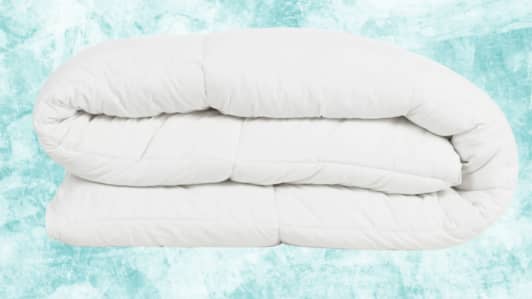
Comforters made from high-quality materials can be an expensive investment, but Olive + Crate bucks this trend with the Bamboo Comforter. Despite a thoughtful design and durable construction, the comforter costs much less than most competitors in the online bedding market.
Pros & Cons
Pros
- Viscose shell is soft, smooth, and highly breathable
- Lush down alternative fill is a blend of recycled polyester and bamboo-derived fibers
- Corner loops secure the comforter to a duvet cover
Cons
- Size options limited to queen and king
- Too large for some household washing machines
Full Details
Best Luxury
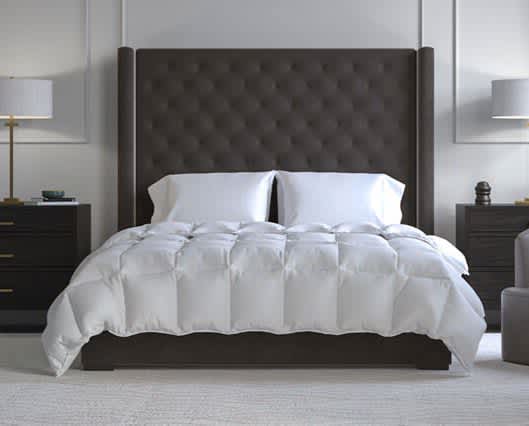
The Saatva All-Year Down Alternative Comforter is a good example of the brand’s uncompromising standards. Using organic and Fair Trade Certified materials, the comforter has a luxurious feel that is suitable for all seasons. Excellent durability and easy care make this model a good option for a wide range of sleepers.
Pros & Cons
Pros
- Organic cotton shell with a crisp percale weave
- Fluffy and breathable down alternative fill
- Can be used with a duvet cover
Cons
- Sticker price is on the expensive side
- Frequent fluffing needed to maintain a full shape
Full Details
Most Comfortable
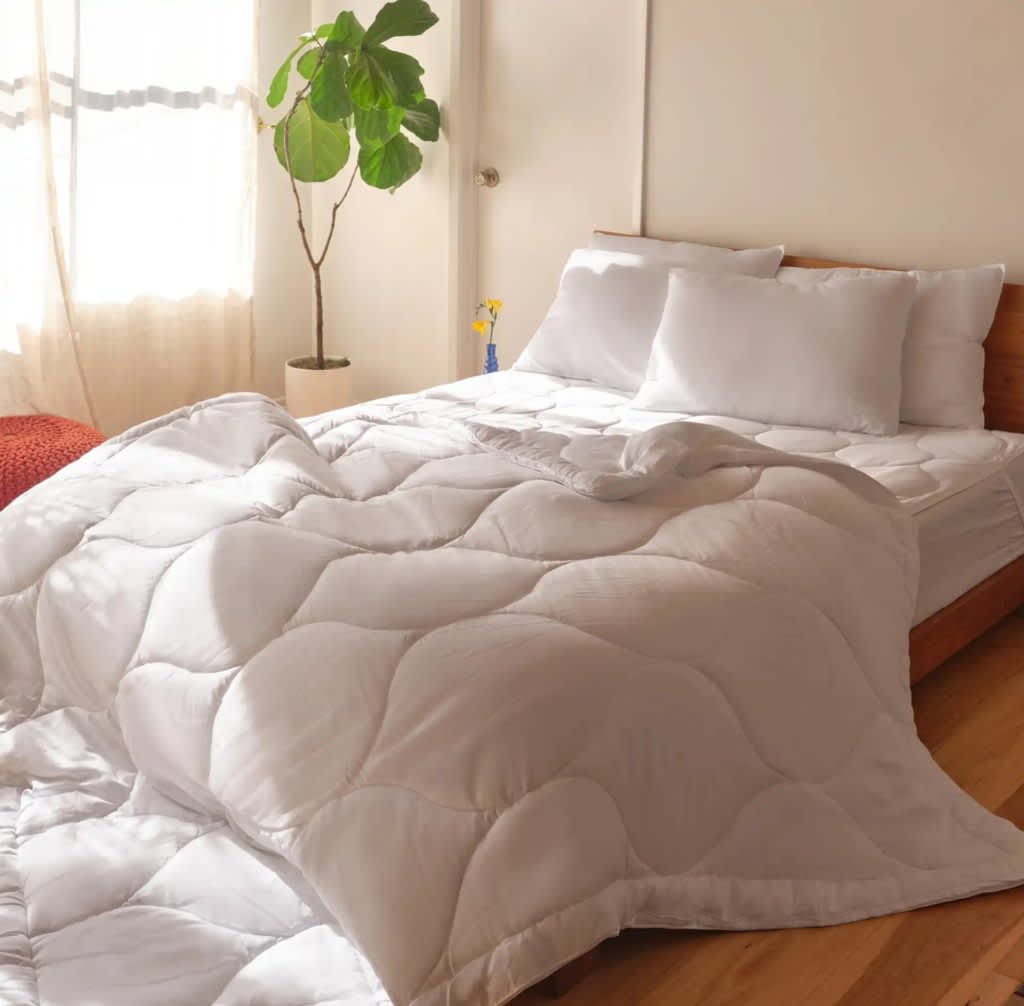
Notably soft and lightweight, the Buffy Cloud Comforter is designed for year-round use. Sustainable materials and carbon neutral shipping make this model a great choice for eco-minded shoppers.
Pros & Cons
Pros
- Breathable Tencel shell with a silky sateen weave
- Super fluffy recycled PET fill
- Designed for year-round use
Cons
- Shifting or clumping may occur
- Larger sizes may not be compatible with certain household washing machines
Full Details
Softest
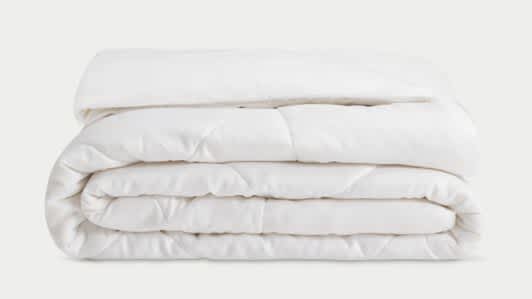
Cozy Earth’s silky-soft Bamboo Comforter offers a plush feel and comes oversized for added comfort. Made entirely from breathable viscose, the lightweight design cradles sleepers without absorbing much heat. The bamboo-derived cover features a silky and cooling sateen weave. The weave also resists pilling. Viscose fiber fill gives the comforter a fluffy feel.
Pros & Cons
Pros
- Made entirely from soft and breathable viscose
- Two fill choices
- 10-year warranty
Cons
- Much more expensive than average
- Frequent fluffing needed to maintain full loft
Full Details
Best Cooling
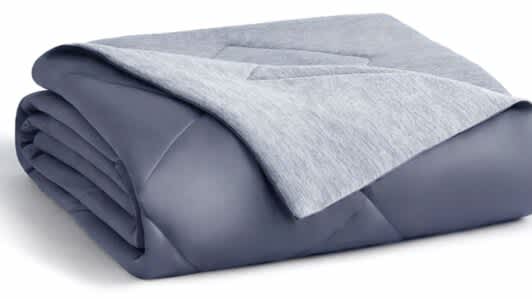
The Zonli Z-Magic Cooling Comforter is a dual-sided comforter designed with hot sleepers in mind. Each side is made with a different material and feel, but both help keep you at a neutral temperature throughout the night.
Pros & Cons
Pros
- Dual-sided design offers a different feel on each side
- Lightweight construction
- Machine-washable
Cons
- Sticker price is more expensive than average
- Limited sleep trial compared to the competition
Full Details
Best All-Season
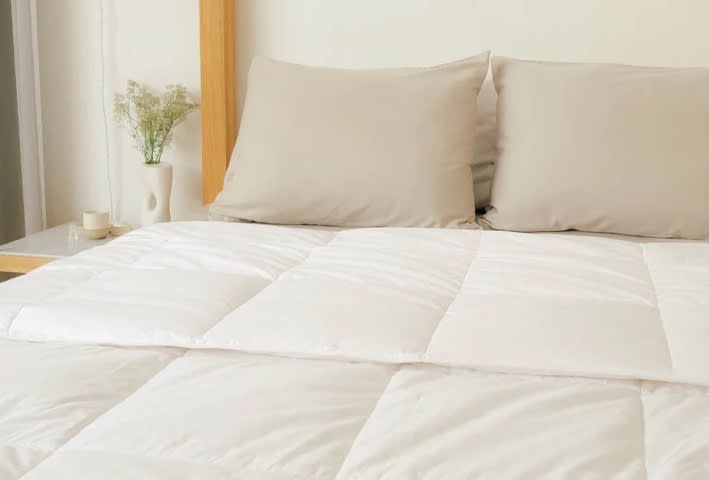
The Slumber Cloud Comforter has a temperature-regulating design that makes it suitable for different seasons. If you’re looking for a comforter that’s cozy and warm but can stay on your bed year-round, this one checks off many boxes.
Pros & Cons
Pros
- ClimaDry fiberfill and cotton shell help minimize overheating
- Thick, lofty design
- Machine-washable
Cons
- May not provide enough insulation in exceptionally chilly weather
- Not compatible with smaller washing machines
Full Details
Best Weighted
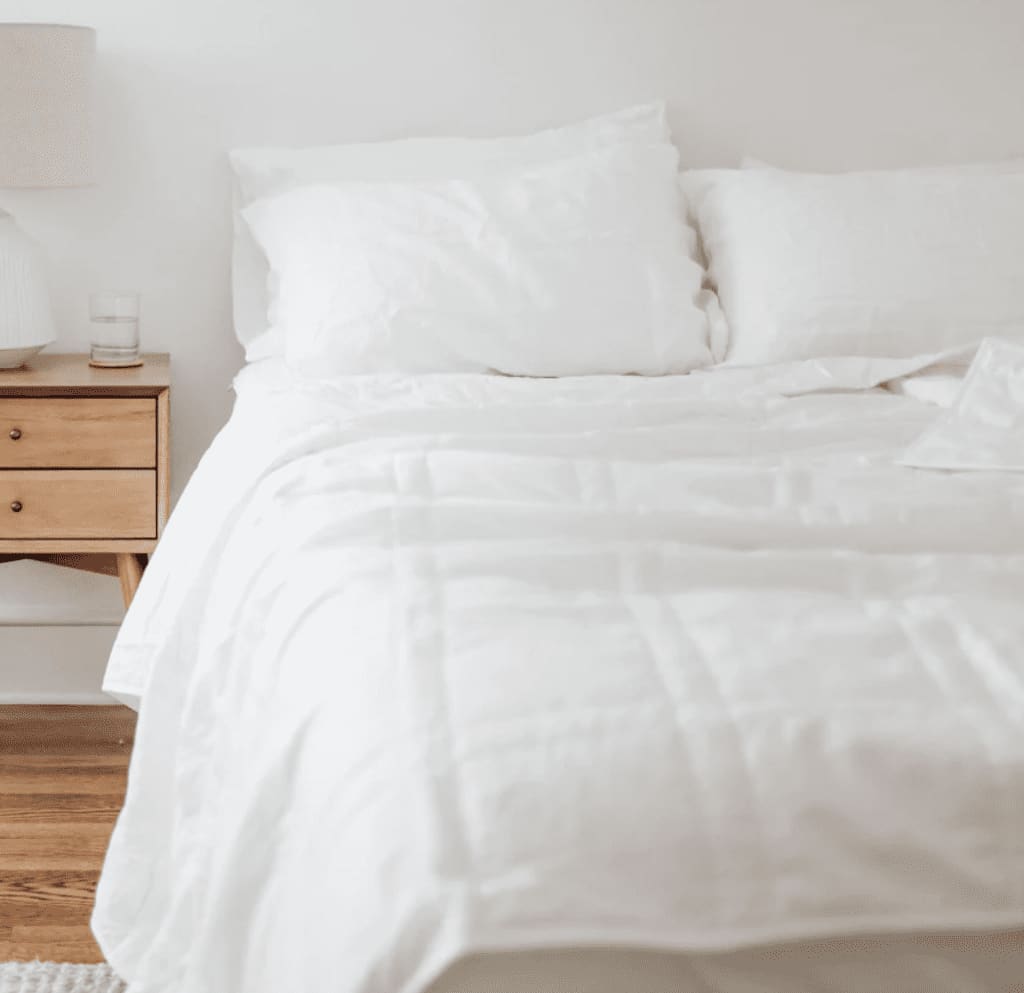
If you’re looking for a covering that combines the softness and loftiness of a traditional comforter with the gentle compression of a weighted blanket, then the Baloo Weighted Comforter might be a worthwhile investment. You can choose from weights of 15, 20, or 25 pounds. Using the “10% rule” as a guide with a little wiggle room in either direction, this makes the comforter best suited to people who weigh anywhere from 120 to 280 pounds.
Pros & Cons
Pros
- Available in weights of 15, 20, or 25 lbs.
- All designs are oversize to accommodate couples
- Breathable cotton shell and glass microbead fill
Cons
- Too large for most household washing machines
- Steep sticker price may be a barrier for shoppers with tight budgets
Full Details
How We Test
If you decide on one of our best comforter picks, you can rest assured in more ways than one. We’ve tried every comforter on our list personally and our testers have vetted the included models for quality and comfort.
In our sleep lab, we lie under every model to see how they feel and where they fall on the insulating versus temperature-regulating spectrum. We also inspect fill material, shell fabric, and washability — all important qualities to think about.
Customer reviews help us understand how a comforter performs over time, so we seek out verified reviews that discuss durability, performance, and overall quality before making our final choices.
What Is a Comforter?
Comforters are designed to add warmth and comfort to a bed. They cover top sheets and come in a variety of materials like down, polyester, cotton, wool, and silk.
Comforters feature a cover and built-in insert. A comforter’s feel and performance largely depend on its materials and craftsmanship. Some designs are thin and airy, while others are more substantial.
While they’re distinct from mattress pads and protectors, comforters can shield your mattress and bedding from surface spills or accidents. Since most people in the U.S. use a top sheet as a barrier, comforters don’t need to be washed as frequently.
Comforter vs. Duvet
Many shoppers think comforters and duvets are identical since they serve the same basic function. However, they do vary slightly in performance and care.
Duvet is a French word that means down and refers to the fine plumage commonly used in duvet fills. Duvets have a fluffy insert and a removable cover. Inserts today consist of a number of natural and synthetic materials as well as down or feathers. Covers are meant to be washed on a regular basis, while inserts are usually spot-treated.
The main difference between a comforter and duvet is that a comforter has a built-in cover, whereas a duvet cover is detachable for easier cleaning. This distinction stems from the fact that top sheets are more commonly used in the U.S. as a buffer between the comforter and sleeper, while Europeans tend to only use a duvet. Without a sheet to serve as a barrier, it makes sense that duvets are designed for greater ease of cleaning.
Comforter |
Duvet |
|
Pros |
|
|
Cons |
|
|
One of the main reasons to choose a comforter over a duvet insert and cover combo is washability. That said, not all models have straightforward care instructions. If you know you plan to wash your comforter often, check to make sure it’s machine-washable.
How Much Does a Comforter Cost?
The average comforter ranges from $75 to upward of $250. Pricing depends mostly on materials, size, and brand name. There are plenty of budget-friendly comforters available, but shoppers can also splurge on a number of luxury models. Expect to pay more for designs made with natural, organic, or ethically sourced materials.
How Long Does a Comforter Last?
Most quality comforters should last around 10 to 15 years. Lifespan varies based on material quality, workmanship, and how well you care for your comforter. Some materials are naturally more durable and hold up to washing better than others. Following proper care guidelines can prevent premature wear.
How to Clean and Care for a Comforter
Care instructions differ according to model, so it’s important to refer to the product label before washing your comforter, as properly caring for your comforter can extend its lifespan.
Regardless of model, you can protect your comforter by not eating in bed and using a duvet cover. These practices will reduce how frequently you need to wash your comforter.
If your comforter is machine-washable and your washing machine is large enough to accommodate it, it’s safest to use a delicate setting with cold or warm water and a mild detergent. Avoid using hot water. Many comforters can be machine-dried on a low setting, but a large capacity dryer may be necessary. Additionally, air-drying in the sun can refresh a comforter. Since comforters are often difficult to wash, minor stains can be spot-treated instead.
What Types of Comforters Are Available?
Comforters use a variety of materials to achieve different feels. Depending on the model, a shell might use entirely different materials from the fill. Knowing how each type of material impacts the feel of a comforter can help point you to the right fit.
Down and Down Alternative
Natural down comes from the fine down feathers of geese or other waterfowl. Notably soft and fluffy, down remains a popular fill material. Down comforters are lightweight and breathable, yet they also insulate well during colder months.
Some people are allergic to natural down, and not everyone is comfortable with animal-sourced products. Down alternative fill is a more suitable option in these scenarios, as it consists of synthetic fibers. Most down alternative is polyester-based and has a feel similar to natural down. Down alternative comforters vary greatly when it comes to breathability, loft, and durability. Some high-end models are virtually indistinguishable from natural down comforters.
Cotton
Cotton is a natural fiber widely used in bedding for its softness and breathability. Cotton shells can help sleepers stay cooler by wicking away heat and moisture. Cotton fill comforters tend to be lighter and less insulating than other materials like down or wool, making them a good choice for summer months.
Silk
Silk is more common in luxury comforters, as it’s more expensive to manufacture. The natural fiber is exceptionally smooth and lightweight. Silk comforters are popular in hot and humid climates because of their breathability.
Wool
Wool comforters are very soft and insulating, making them suitable for colder seasons. They tend to be less fluffy than down or polyester models. Because wool is moisture-wicking, even very heavy wool comforters remain fairly breathable.
Eucalyptus
Eucalyptus fibers have a cooling, silky-soft texture that can be soothing to sensitive skin. Shells made from eucalyptus tend to be lightweight yet durable. They also drape well and resist wrinkling.
Most eucalyptus bedding is eco-friendly since it requires less water to manufacture than other materials. Eucalyptus comforters tend to avoid harsh chemicals in the manufacturing process as well.
A major plus for comforters is that you only have to buy one thing if you don’t plan on using a cover. That extra savings means you may be able to spring for a high-quality option.
What Should You Consider When Choosing a Comforter?
Everyone has different needs and preferences when it comes to bedding. Some people tend to overheat at night, while others require extra insulation to stay comfortable.
Consider your mattress size, material preference, bedroom aesthetic, and budget when shopping for your next comforter.
Your Mattress Size
Sizing options vary according to manufacturer, but all are designed to fit standard mattress sizes. Many models come in single sizes, such as twin, twin XL, queen, king, and California king. Other companies consolidate sizes for greater versatility. Full/queen and king/California king are common examples.
To ensure a good fit, always double-check your mattress size before buying a comforter, particularly if you share a bed. A comforter that is too small may not cover both partners in bed. A larger size is less problematic, and some sleepers even prefer oversized models.
For combined sizes, often more than one option can fit a given mattress. Just keep in mind that comforter prices generally increase with size.
Your Budget
Being clear on your budget prior to shopping can help narrow your search. Those with larger means naturally have more options, but there are plenty of models for shoppers on stricter budgets. Look for discounts or holiday sales to cut down on costs. Be sure to factor in potential shipping fees to the overall cost.
Your Personal Preferences
Some people enjoy a very lightweight and fluffy comforter, while others appreciate more heft. Consider the climate you live in and your typical bedroom temperature to help determine an appropriate insulation level.
Materials
Materials directly impact the way a comforter feels and performs. Shoppers should consider any allergies they have when choosing materials. For those who avoid animal-derived products, some models are vegan certified.
